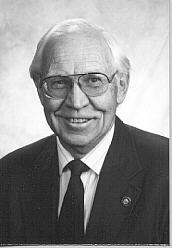1999 Distinguished Lecture Series: Robert J. Weimer
125 Years of Earth Science Programs at CSM: Lessons for the Future
Biography
 Robert J. Weimer, geologist and educator, was born in Glendo, Wyoming on September 4, 1926. After service in the U.S. Navy, Bob attended the the University of Wyoming, receiving a BA in Geology in 1948 and a MA in 1949; and, at Stanford University, receiving a Ph.D. in 1953.
Robert J. Weimer, geologist and educator, was born in Glendo, Wyoming on September 4, 1926. After service in the U.S. Navy, Bob attended the the University of Wyoming, receiving a BA in Geology in 1948 and a MA in 1949; and, at Stanford University, receiving a Ph.D. in 1953.
From 1949-1954 he was a geologist with Union Oil Company of California working in the Rocky Mountains and Permian Basin. He continued as a consultant from 1954-1957. He joined the faculty at Colorado School of Mines in 1957 and taught there until his retirement as Getty Professor of Geology in 1983. He is currently Professor Emeritus of Geology and continues to lecture in courses, run field trips, and conduct research. During his tenure at Mines, he taught many courses and advised and directed over fifty graduate students, while assisting at least twice that number by serving on committees and aiding the direction and focus of their research. Bob was department head from 1964-1969.
Bob has been visiting professor at the University of Colorado (1961), University of Calgary (1970), and the Institute of Technology at Bandung, Indonesia (1975) and has lectured at many universities in the US and abroad. He has been a distinguished lecturer in the Fulbright program at the University of Adelaide (Australia), and for the AAPG and SEG. In addition to serving on many national committees, he has published numerous notes, articles and books.
Bob has served in many capacities for professional and technical organizations. He was president of AAPG (1991-1992), and president of SEPM (1972). For application of stratigraphic principles to exploration, and for promoting continued professional education, he was elected to membership in the National Academy of Engineering in 1992. He has received many honors and awards, most notable the Sidney Powers Medal from the AAPG (1984), the SEPM Twenhofel Medal (1995), the Mines Brown Medal (1990) and the AIPG Parker Medal (1986).
Science is advanced through research and education, and geology is no exception. On the outcrop and in the core lab, Bob is quick to point out that the rocks do not change, but how we interpret them does.
Although we are all educated in science, in actual practice few of us make scientific breakthroughs in a visionary manner. The visionaries who teach are “masters” whose legacy is like a masterpiece of art. You can try to emulate or reproduce it, but it never equals the original. A master sets a standard by producing a masterpiece. Students lucky enough to be educated by the Master experience the value of learning how to bring out their own originality and creativity. This is the greatest gift that an educator can make to students.
Abstract
The needs of society are fulfilled by the availability of natural, agricultural and human resources. Without adequate food, water, energy, shelter, materials and environment, much of the world’s population as it currently exists would be doomed to a premature death.
By educating students for professional careers and conducting research in the discovery, production and beneficence of natural resources for 125 years, Mines has provided two of the resources essential to mankind. And by its dedication of purpose and the success of graduates and faculty, Mines has earned an international reputation as a premier natural resources college. In the last 35 years, degree offerings have been broadened to include other fields of engineering and economics, but the core programs in mineral engineering remain viable and continue their historical contributions to society.
In as much as geology has been taught throughout the entire 125-year history of Mines, the staff and students of earth science programs have played an important role in the Mines success story. The purpose of this paper is to present a short historical account of the people and programs in geology, geophysics and geochemistry, which have been in lock step with, and supported by, all other academic programs as they contribute to Mines’ mission. To fulfill the slogan “world’s foremost school of mineral engineering” all students for many years were required to take four courses in geology in the core engineering curriculum; about one-half of the students would take as many as six or seven courses. Thus, the Geology Department grew because of a large service load in addition to its degree granting activities, at both the undergraduate and graduate levels.
